Groups Were to Meet Together in Chicago Next Year
McElroy Rejects J-Director Job After ‘DEI Hysteria’
CNN’s Victor Blackwell Finds Audacious Ancestors
Homepage photo: At the “Celebration of Color” official opening reception Wednesday at the National Association of Hispanic Journalists convention (Credit: Twitter)
Support Journal-ismsDonations are tax-deductible.
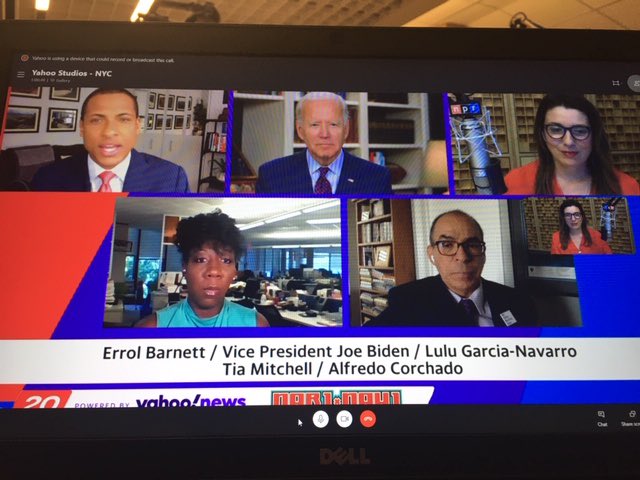
Groups Were to Meet Together in Chicago Next Year
The National Association of Hispanic Journalists is pulling out of a planned election-year joint convention with the National Association of Black Journalists in Chicago in 2024, advertising in its program booklet that the 3,700-member NAHJ is holding its own 40th anniversary conference in Hollywood, Calif.
Drew Berry, executive director of NABJ, reiterated to Journal-isms Thursday, “We’re going to be in Chicago,” speaking of his own organization. Berry made a brief visit to the NAHJ convention in downtown Miami.
“No comment,” said NAHJ president Yvette Cabrera, asked about the status of the joint convention at her group’s opening reception Wednesday. An official announcement is likely to be made Saturday at NAHJ’s annual Hall of Fame Gala and Awards Ceremony. It could not be determined what, if any, legal or financial consequences there might be for NAHJ.
[Updating: NAHJ said Friday: “The decision to host independent conventions was borne out of a mutual interest in commemorating NAHJ/NABJ milestone anniversaries with individual conferences in separate cities in 2024.” It said that the “no comment” referred to a question about what was discussed in the board’s executive session.
[The articles of incorporation for NAHJ were signed in February of 1984. NABJ dates its founding to Dec. 12, 1975.
[Berry messaged Friday, “We’ll have a joint statement this weekend.”]
The NABJ website is still advertising the joint convention effort. “Join us for an extraordinary gathering filled with innovative programs, remarkable presenters and fantastic networking opportunities, as NABJ & NAHJ members, partners, colleagues and supporters come together in Chicago, Illinois for the 2024 NABJ-NAHJ Convention and Career Fair,” it says. “July 31, 2024 12:00 am – August 4, 2024.”
[Update: NAHJ’s name was removed Friday from NABJ’s description of the 2024 convention.]
The stand-alone NAHJ convention is to take place in May, according to the program booklet.
The behind-the-scenes machinations over NAHJ’s pullout were largely kept out of earshot of convention goers, who arrived as some media organizations are ramping up their efforts to attract Latinos, or publicizing the importance of the Hispanic audience.
Just a few examples:
- Gannett, though it has recently undertaken layoffs, has advertised for a director of Latino initiatives.
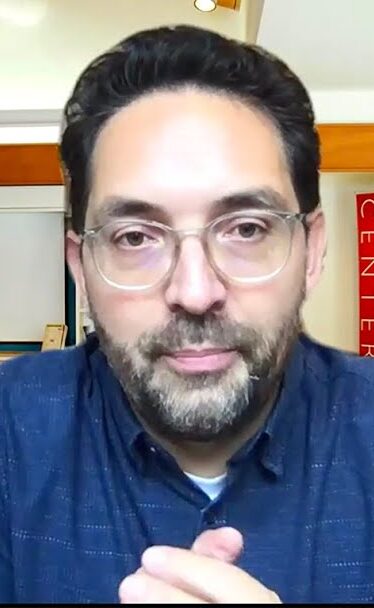 The New Yorker has hired Geraldo Cadava (pictured), a history professor at Northwestern University, as a contributing writer, with a mandate to cover Latino history, politics and culture. “Gerry is the author of two books, ‘The Hispanic Republican: The Shaping of an American Political Identity, from Nixon to Trump’ and ‘Standing on Common Ground: The Making of a Sunbelt Borderland,'” editors David Remnick and Michael Luo wrote staffers, “and is currently writing a history of Latinos over the past five hundred years, to be published by Crown in 2026. He’s also a co-editor-in-chief of Public Books, for which he hosts the ‘Writing Latinos’ podcast. . . .”
The New Yorker has hired Geraldo Cadava (pictured), a history professor at Northwestern University, as a contributing writer, with a mandate to cover Latino history, politics and culture. “Gerry is the author of two books, ‘The Hispanic Republican: The Shaping of an American Political Identity, from Nixon to Trump’ and ‘Standing on Common Ground: The Making of a Sunbelt Borderland,'” editors David Remnick and Michael Luo wrote staffers, “and is currently writing a history of Latinos over the past five hundred years, to be published by Crown in 2026. He’s also a co-editor-in-chief of Public Books, for which he hosts the ‘Writing Latinos’ podcast. . . .”
 The Los Angeles Times announced the launch Friday of De Los, “a community-driven brand and platform . . . . Created as a space to explore all things Latinidad – in Los Angeles and across the country – De Los offers reporting and commentary, graphic comics and topical social videos, a forum to celebrate or critique the news of the day, and a way to connect through a shared sense of culture and identity. . . .”
The Los Angeles Times announced the launch Friday of De Los, “a community-driven brand and platform . . . . Created as a space to explore all things Latinidad – in Los Angeles and across the country – De Los offers reporting and commentary, graphic comics and topical social videos, a forum to celebrate or critique the news of the day, and a way to connect through a shared sense of culture and identity. . . .”
- NAHJ claimed success in persuading the L.A. Times to add three journalists of color to its investigative team. More on that later.
- A Hispanic radio conference was told that “the Hispanic population experienced remarkable growth. . . . Projections indicate that the Hispanic population will reach 111.2 million by 2060, comprising 27.5% of the total U.S. population. This expanding demographic presents exciting opportunities for the radio industry as the listener base continues to grow explosively,” Radio Ink reported.
The roots of the joint conventions between NABJ and NAHJ go back as far as the 1980s, when Juan González, an active member of NAHJ, and Will Sutton Jr., an active member of NABJ, started comparing notes about their experiences as journalists of color. The two men, both in Philadelphia, met in 1986. Separately, in 1988, DeWayne Wickham, then NABJ president, convened the first joint meeting of the boards of NABJ, NAHJ, the Asian American Journalists Association and the Native American Journalists Association. They became Unity: Journalists of Color, later Unity: Journalists for Diversity.
 When that coalition dissolved in 2018, NABJ and NAHJ continued to periodically meet jointly, most recently in 2022 in Las Vegas. That gathering drew 4,750 registrants, Berry told the NABJ board in October. NABJ attracted 3,417 and NAHJ 1,333 to Las Vegas for the Aug. 3-7 event.
When that coalition dissolved in 2018, NABJ and NAHJ continued to periodically meet jointly, most recently in 2022 in Las Vegas. That gathering drew 4,750 registrants, Berry told the NABJ board in October. NABJ attracted 3,417 and NAHJ 1,333 to Las Vegas for the Aug. 3-7 event.
This year, the Hispanic journalists group counted 1,550 registrations, according to preliminary figures, Yaneth Guillen-Diaz, interim chief operating officer, told a board of directors meeting Wednesday. Guillen-Diaz, who had been senior director of training and membership, was appointed interim COO after the resignation of Executive Director David Peña Jr., on June 30, effective July 28. Peña said then he would not be at the convention.
The 1,550 registration figure was more than the 1,300 the host hotel, the InterContinental Miami, could accommodate, and the group established a waiting list. Registration closed two days early.
Some attendees mentioned Peña’s resignation as they networked and greeted friends and colleagues, but the development received scant attention at Wednesday’s board meeting. The most debated item was a motion that established guidelines on communications.
Mc Nelly Torres, national vice president, digital, called the guidelines “fascistic,” while Julio Cesar Chavez, national vice president, broadcast, argued that “we are a professional organization and we will have professional standards.”
[Updated July 14: NAHJ says the guidelines state, “Should a board member feel obligated or to share information publicly they believe is relevant to the ethical operation of the NAHJ outside the board, they should notify the president as such public remarks can impact the organization and must be vetted for facts.
[“These policies do not censor board members who feel a deep sense of duty or conviction in reporting facts they find crucial to helping the NAHJ course correct on any matter.
[“However, board members must thoroughly vet and verify and exhaust all communication avenues for resolution before taking a drastic step toward publicizing internal board matters and ensure they are sharing factual and accurate information.
[“The goal is to discourage the spread of disinformation and prevent actors from weaponizing information – maladies of our present age.”]
The rules passed overwhelmingly on a roll-call vote.
The board also heard about the success of palabra, a multimedia platform in which “NAHJ freelance members cover stories and communities that have been disregarded in larger news outlets based on the ideology that ‘ethnic’ news is only an issue for marginalized communities and not a human issue.” Over the past 18 months, palabra has attracted 99 contributors and published 162 stories, 85 of them original and 28 of them bilingual, said managing editor Valeria Fernandez. She cited syndication with the digital group Advance Local.
NAHJ held a news conference Wednesday to discuss a preliminary report showing “an alarming lack of parity on investigative news teams, along with key areas of concern and calls for creating strategies for improvement.”
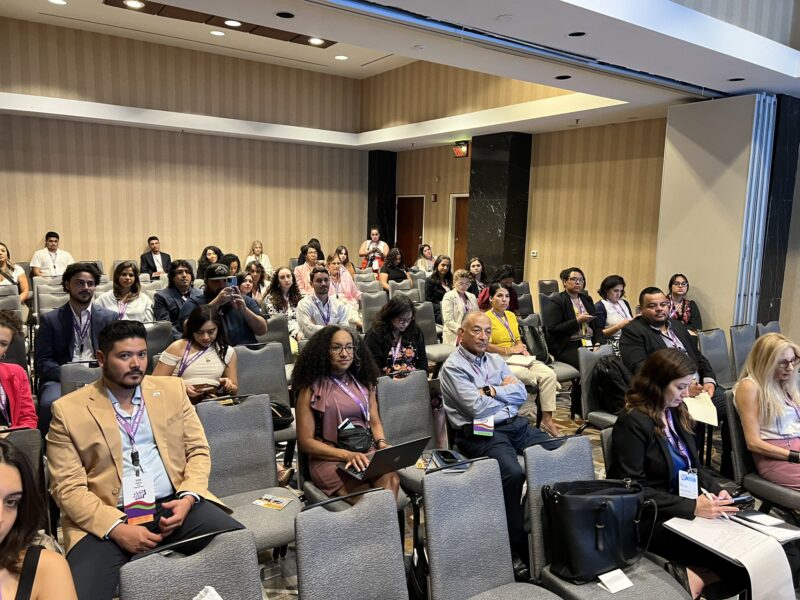
But the organization claimed success in persuading the Los Angeles Times to add three journalists of color to its investigative group. “The Times added these three staffers to the investigative team from within the organization, moving them to the investigations team after the Task Force strike team met with the Los Angeles Times last year,” messaged Cabrera. “They are journalists of color. Here’s the announcement.
“In a separate meeting with NAHJ more recently, [Executive Editor] Kevin Merida gave credit to our team for having the dialogue with the Times, which prompted the moves internally.”
Among the plenary sessions and meal events this year were “Climate Change and Environmental Justice,” “Artificial Intelligence,” “Colorism in Professional Advancement,” “Violence Against Journalists Here and Abroad,” “Covering Florida’s ‘Don’t Say Gay’ and Other Speech-Suppressing Initiatives,” “Impact of the Lack of Latinos in Investigative Teams” and “Misinformation/Disinformation U.S. Latino Community.”
Placed among the media groups and others at the career fair was a table from the little-known Office of Diversity and Inclusion of the U.S. House of Representatives, founded in 2020 under the administration of former Democratic House Speaker Nancy Pelosi and continued under Republican Speaker Kevin McCarthy.
“We’re interested in educating our communities about careers in Congress,” Deputy Director Jeyben Castro told Journal-isms.
 One staple of this and similar conventions has been advice to young journalists. Cecilia Vega (pictured), a correspondent for CBS’ “60 Minutes” who until January was a White House correspondent and weekend anchor for ABC News, spoke at such a session Wednesday.
One staple of this and similar conventions has been advice to young journalists. Cecilia Vega (pictured), a correspondent for CBS’ “60 Minutes” who until January was a White House correspondent and weekend anchor for ABC News, spoke at such a session Wednesday.
Vega told the “collegiate ’emerging journalist’ convention orientation” that life for beginning reporters can be one of inconvenient hours and workdays, but that even as a White House correspondent, she had to worry about work-life balances. Covering the White House was demanding, she said, but “doing it under [President Donald] Trump was like drinking from a firehose,” she told Journal-isms afterward. “It didn’t stop for four years. How do you find that balance? I didn’t do it successfully … because it is so all-consuming.
“At the end of four years, I said, ‘I need to slow down a bit,’ ” asking herself how one could keep up such a pace.
Then came a call from “60 Minutes.” Was the stress of covering that demanding White House beat the reason Vega took the offer?”
No, Vega said.
She left “because it’s 60 Minutes,” a dream assignment and the most-watched show on television.
If CBS calls with an enviable job offer like that, “you go.”
- Anthony Bautista, Latino Reporter: NAHJ pulls out of joint 2024 conference with Black journalists association
- Michael Butler, Miami Herald: Hispanic journalism convention kicks off in Miami, one of America’s most diverse cities
- Daniela Cazares, Latino Reporter: NAHJ has new rules about how and when board members can talk to each other, the public
- Gisselle Medina, Latino Reporter: NAHJ executive director resigns abruptly. Search for successor to begin after conference.
- Xiomara Villarreal-Gerardo, Latino Reporter: NAHJ hosts mask-optional Miami convention, prioritizes attendee choice and safety
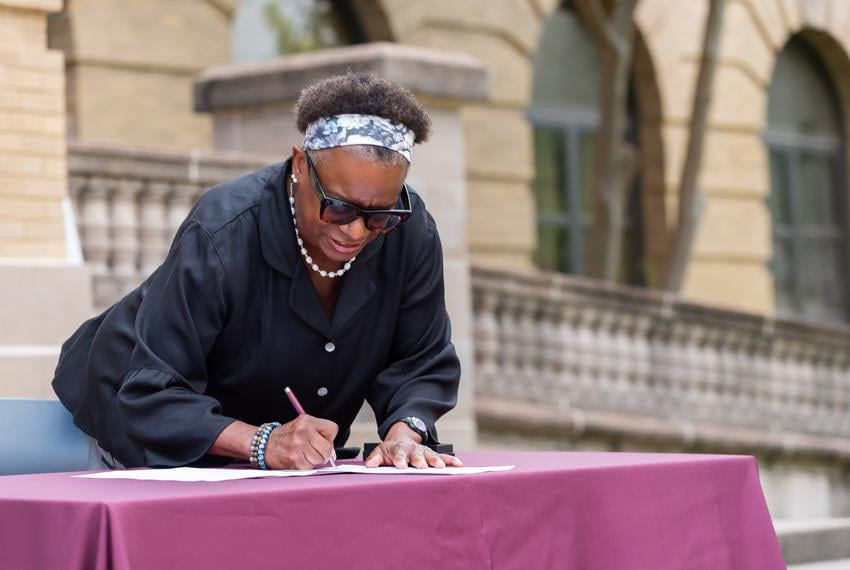
McElroy Rejects J-Director Job After ‘DEI Hysteria’
In a case echoing Nikole Hannah-Jones’ experience in 2021 at the University of North Carolina, Kathleen O. McElroy has declined an offer to become the director of Texas A&M University’s new journalism school. McElroy cited concerns about “DEI hysteria” (Diversity, Equity, and Inclusion) as the reason behind the university’s decision to water down her contract, as Reform Austin reported this week, citing an interview McElroy gave to the Texas Tribune.
On live television, Hannah-Jones told “CBS This Morning” co-host Gayle King on July 6, 2021, that she was spurning a faculty appointment at the University of North Carolina at Chapel Hill to instead start a center for investigative journalism at Howard University. She had been courted by UNC for a Knight Chair, but the school’s namesake donor Walter E. Hussman Jr. was said to have objected to the “1619 Project” author, leading to delays in an offer including tenure.
In McElroy’s case, the Texas A&M University offer “included the kind of fanfare usually reserved for college coaches and athletes” in announcing her hire, Kate McGee reported Tuesday for the Tribune.
“The university set up maroon, silver and white balloons around a table outside its Academic Building for an official signing ceremony.” It was there that McElroy, “a respected journalist with a long career, officially accepted the position to run the new program and teach as a tenured professor, pending approval from the Texas A&M University System Board of Regents.
“McElroy, a 1981 Texas A&M graduate, was the director of the University of Texas at Austin’s School of Journalism between 2016 and 2022, where she is a tenured professor. Earlier, she spent 20 years in various editing roles at The New York Times until heading to UT-Austin to pursue her doctorate.
“She has studied news media and race, with a focus on how to improve diversity and inclusion within newsrooms, and spent her career covering other areas like sports and obituaries. Her master’s thesis focused on the obituaries of civil rights leaders. Now, she was excited to head back to her alma mater to build a brand new program there.
“But in the last several weeks, McElroy told The Texas Tribune, the deal with Texas A&M fell apart.
“In the days after the signing ceremony, she said, A&M employees told her an increasingly vocal network of constituents within the system were expressing issues with her experience at the Times and with her work on race and diversity in newsrooms, McElroy said.
“Behind the scenes, A&M spent weeks altering the terms of her job. After hearing about the concerns, McElroy agreed to a five-year contract position without tenure, which would have avoided a review by regents. On Sunday, she received a third offer, this time with a one-year contract and emphasizing that the appointment was at will and that she could be terminated at any time. She has rejected the offer and shared all of the offer letters with the Tribune.
“The situation comes at a fraught time at Texas public universities. Schools are preparing for a new state law to go into effect in January that bans offices, programs and training that promote diversity, equity and inclusion. Recently, the Texas A&M System started a systemwide audit of all DEI offices in response to the new law. . . .”
Alums told the Eagle, newspaper at Texas A&M University, of their anger and disappointment.
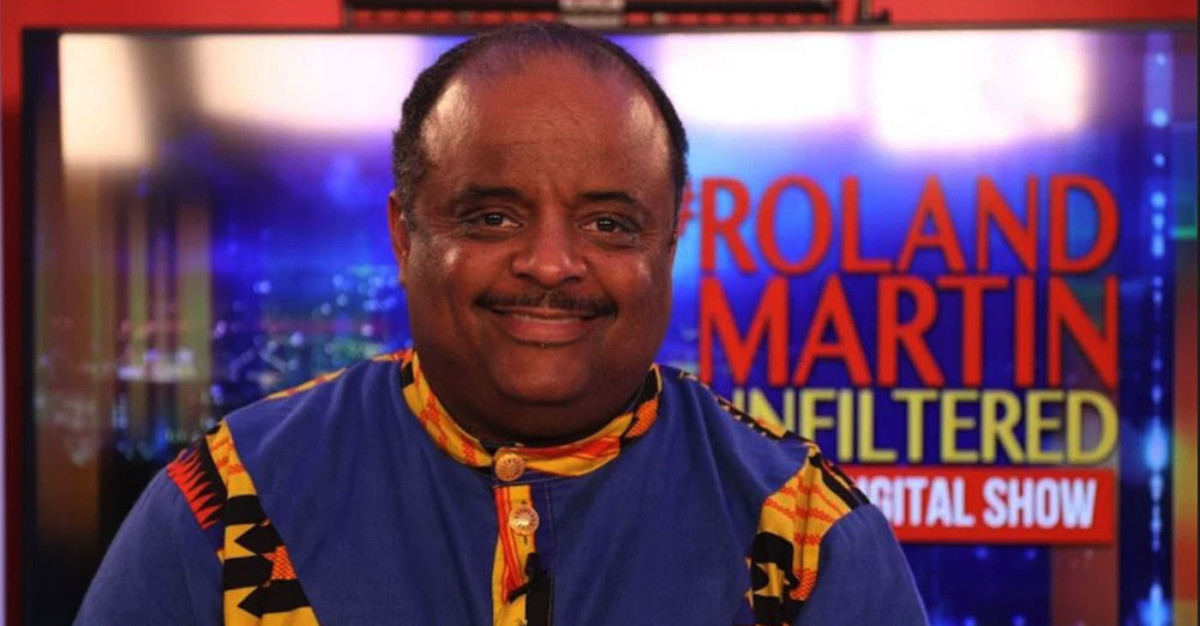 “For the first time ever, Roland Martin (pictured) is ashamed to be an Aggie,” Alex Miller reported.
“For the first time ever, Roland Martin (pictured) is ashamed to be an Aggie,” Alex Miller reported.
“Martin, A&M Class of 1991 and longtime journalist and political analyst, called the actions by A&M leadership that caused McElroy to spurn her offer to return to her alma mater petty and childish.
“ ‘What Texas A&M is saying is that someone like me, who is in three halls of fame, somehow isn’t good enough for A&M,’ Martin said. ‘This situation is why Texas A&M is considered by many to be a second-rate university. Actions like this is why we will never be considered one of the nation’s preeminent universities.’
“Numerous other A&M former students took to social media to express their thoughts and opinions on McElroy’s situation, including a pair of fellow esteemed journalists.
“Charean Williams, A&M Class of 1986, NFL reporter and A&M Distinguished Alumnus, wrote on Twitter: ‘A&M’s loss is Texas’ gain. It’s disheartening, frustrating and embarrassing, and worse that we do this to one of our own.’
“Richard Oliver, A&M Class of 1981 and longtime Texas sportswriter, said: ‘That [McElroy] is being forced to retreat from new position at her beloved alma mater [A&M] because of anonymous concerns about her race, gender and background is shameful. I have always been proud to be an Aggie. Today, not so much.’
“A&M’s Former Journalism Students Association released a a statement on McElroy’s departure Wednesday afternoon and said news she is no longer coming to A&M is a major loss. . . .”
CNN’s Victor Blackwell Finds Audacious Ancestors
An estimated 16.6 million people have tuned in to Henry Louis Gates’ PBS show “Finding Your Roots,” in which the Harvard scholar traces his guests’ ancestry. And now CNN anchor Victor Blackwell can testify to the emotional impact such discoveries can have.
Blackwell visited the new International African American Museum in Charleston, S.C., and traced his own family tree with resources from the museum’s Center for Family History.
“ ‘Make sure you got a box of Kleenex by you, and sit there and enjoy,’ the museum’s top genealogist, Shelley Murphy, advised him via laptop from the University of Virginia as she guided him back to 1712.”
The journey revealed “a wending saga starring two enslaved women whose audacity and legal dexterity paved the way for their descendants’ freedom and opportunity,” CNN’s Devon M. Sayers reported June 19.
To subscribe at no cost, please send an email to journal-isms+subscribe@groups.io and say who you are.
Facebook users: “Like” “Richard Prince’s Journal-isms” on Facebook.
Follow Richard Prince on Twitter @princeeditor
Richard Prince’s Journal-isms originates from Washington. It began in print before most of us knew what the internet was, and it would like to be referred to as a “column.” Any views expressed in the column are those of the person or organization quoted and not those of any other entity. Send tips, comments and concerns to Richard Prince at journal-isms+owner@
View previous columns (after Feb. 13, 2016).
View previous columns (before Feb. 13, 2016)
- Diversity’s Greatest Hits, 2018 (Jan. 4, 2019)
- Book Notes: Is Taking a Knee Really All That? (Dec. 20, 2018)
- Book Notes: Challenging ’45’ and Proudly Telling the Story (Dec. 18, 2018)
- Book Notes: Get Down With the Legends! (Dec. 11, 2018)
- Journalist Richard Prince w/Joe Madison (Sirius XM, April 18, 2018) (podcast)
- Richard Prince (journalist) (Wikipedia entry)
- February 2018 Podcast: Richard “Dick” Prince on the need for newsroom diversity (Gabriel Greschler, Student Press Law Center, Feb. 26, 2018)
- Diversity’s Greatest Hits, 2017 — Where Will They Take Us in the Year Ahead?
- Book Notes: Best Sellers, Uncovered Treasures, Overlooked History (Dec. 19, 2017)
- An advocate for diversity in the media is still pressing for representation, (Courtland Milloy, Washington Post, Nov. 28, 2017)
- Morgan Global Journalism Review: Journal-isms Journeys On (Aug. 31, 2017)
- Diversity’s Greatest Hits, 2016
- Book Notes: 16 Writers Dish About ‘Chelle,’ the First Lady
- Book Notes: From Coretta to Barack, and in Search of the Godfather
- Journal-isms’ Richard Prince Wants Your Ideas (FishbowlDC, Feb. 26, 2016)
- “JOURNAL-ISMS” IS LATEST TO BEAR BRUNT OF INDUSTRY’S ECONOMIC WOES (Feb. 19, 2016)
- Richard Prince with Charlayne Hunter-Gault, “PBS NewsHour,” “What stagnant diversity means for America’s newsrooms” (Dec. 15, 2015)
- Book Notes: Journalists Follow Their Passions
- Book Notes: Journalists Who Rocked Their World
- Book Notes: Hands Up! Read This!
- Book Notes: New Cosby Bio Looks Like a Best-Seller
- Journo-diversity advocate turns attention to Ezra Klein project (Erik Wemple, Washington Post, March 5, 2014)

